
Photo illustration: YouTube Content ID vs Adpocalypse
YouTube Content ID uses automated systems to identify and monetize copyrighted content, while the Adpocalypse refers to advertiser-driven restrictions that limit monetization opportunities for creators. Discover how these dynamics impact creators and advertisers in this article.
Table of Comparison
| Feature | YouTube Content ID | Adpocalypse |
|---|---|---|
| Purpose | Automated copyright protection and monetization | Advertiser boycott due to brand safety concerns |
| Launch Year | 2007 | 2017 |
| Impact | Enables rights holders to claim, block, or monetize content | Reduced ad revenue for creators, stricter ad policies |
| Effect on Creators | Potential loss of revenue from claimed videos | Ad revenue drop and demonetization of sensitive content |
| Key Mechanism | Fingerprinting technology to identify copyrighted content | Advertiser withdrawal from controversial content categories |
| Response | Dispute system for copyright claims | YouTube updated ad policies and content guidelines |
Understanding YouTube Content ID: An Overview
YouTube Content ID is a powerful digital fingerprinting system that helps copyright owners manage and protect their content on the platform. It automatically scans videos for copyrighted material, enabling rights holders to monetize, track, or block unauthorized use of their content. Understanding how this system works allows you to navigate copyright issues effectively and maintain control over your creative assets.
The Origins and Impact of the Adpocalypse
The Adpocalypse, a term originating from the early 2010s, describes widespread advertiser boycotts on platforms like YouTube due to ads appearing alongside controversial content, causing significant revenue drops for creators. This shift forced social media companies to implement stricter content policies and advanced AI moderation tools to reassure advertisers and protect brand safety. Your engagement with social media now navigates a more controlled environment aimed at balancing monetization with ethical content standards.
How Content ID Differs from the Adpocalypse
Content ID is a copyright detection system used by platforms like YouTube to automatically identify and manage copyrighted material by matching uploaded videos against a database of protected content. The Adpocalypse refers to a wave of advertiser boycotts and platform-wide ad restrictions triggered by brand safety concerns over inappropriate or controversial content, leading to significant ad revenue losses for creators. While Content ID primarily addresses copyright enforcement and monetization, the Adpocalypse centers on advertiser-driven policies affecting overall content monetization and visibility.
YouTube Content ID: Copyright Protection or Content Suppression?
YouTube Content ID serves as a powerful copyright protection tool, automatically identifying and managing copyrighted material to ensure creators and rights holders receive proper attribution and revenue. However, the system's automated nature sometimes leads to false claims and content suppression, impacting legitimate creators and raising concerns about fair use and creative freedom. Balancing effective copyright enforcement with protecting creators' rights remains a critical challenge in optimizing YouTube's content ecosystem.
Adpocalypse: Effects on Creators and Revenue
The Adpocalypse significantly impacted social media creators by triggering widespread demonetization and reduced ad revenue due to advertisers pulling back over brand safety concerns. You may have noticed stricter content policies and algorithm changes limiting monetization opportunities for many creators across platforms like YouTube. This shift forced creators to diversify income streams through sponsorships, merchandise, and crowdfunding to sustain their revenue in an environment with diminished ad earnings.
Navigating Content ID Claims and Disputes
Resolving Content ID claims on platforms like YouTube requires understanding the system's automated copyright detection and the rights holders' policies. Creators disputing claims should provide clear evidence of ownership or fair use, while preparing to communicate effectively with claimants through the platform's dispute resolution tools. Timely and accurate responses help avoid demonetization and content removal, ensuring continued growth and monetization opportunities on social media.
Demonetization’s Relationship with Content ID
Demonetization significantly impacts creators relying on YouTube's Content ID system, as flagged videos often lose ad revenue despite copyright claims being valid. Content ID automates copyright enforcement, but its stringent policies can inadvertently demonetize original content, reducing financial incentives for creators. The interplay between demonetization and Content ID necessitates clearer guidelines to balance copyright protection with fair monetization for content producers.
Monetization Strategies in a Post-Adpocalypse Era
The post-adpocalypse era demands innovative social media monetization strategies centered on decentralized platforms and blockchain-based economies, enabling creators to earn through direct peer-to-peer interactions. Subscription models leveraging NFTs and token-gated content foster exclusive access and loyalty while reducing reliance on traditional ad revenue plagued by consumer distrust. Harnessing AI-driven personalized marketing and immersive AR/VR experiences further diversifies income streams by enhancing user engagement and brand partnerships in evolving digital ecosystems.
Creator Perspectives: Adpocalypse vs Content ID Systems
Social media creators face challenges from both the Adpocalypse and Content ID systems, which impact monetization and content visibility. The Adpocalypse led to widespread demonetization due to stricter advertising policies, limiting Your revenue potential and requiring strategic content adjustments. Content ID systems automate copyright enforcement, often causing false claims that restrict Your video reach and require dispute processes to protect Your rights.
Future of Content Regulation on YouTube
The future of content regulation on YouTube is expected to incorporate advanced AI-driven algorithms for more accurate detection of harmful or misleading content, enhancing platform safety. Increasing collaboration with regulatory bodies and content creators will shape transparent and consistent policies to balance freedom of expression with community guidelines. Emerging technologies such as blockchain may also influence content verification and copyright management, ensuring integrity and accountability in digital media.
 socmedb.com
socmedb.com